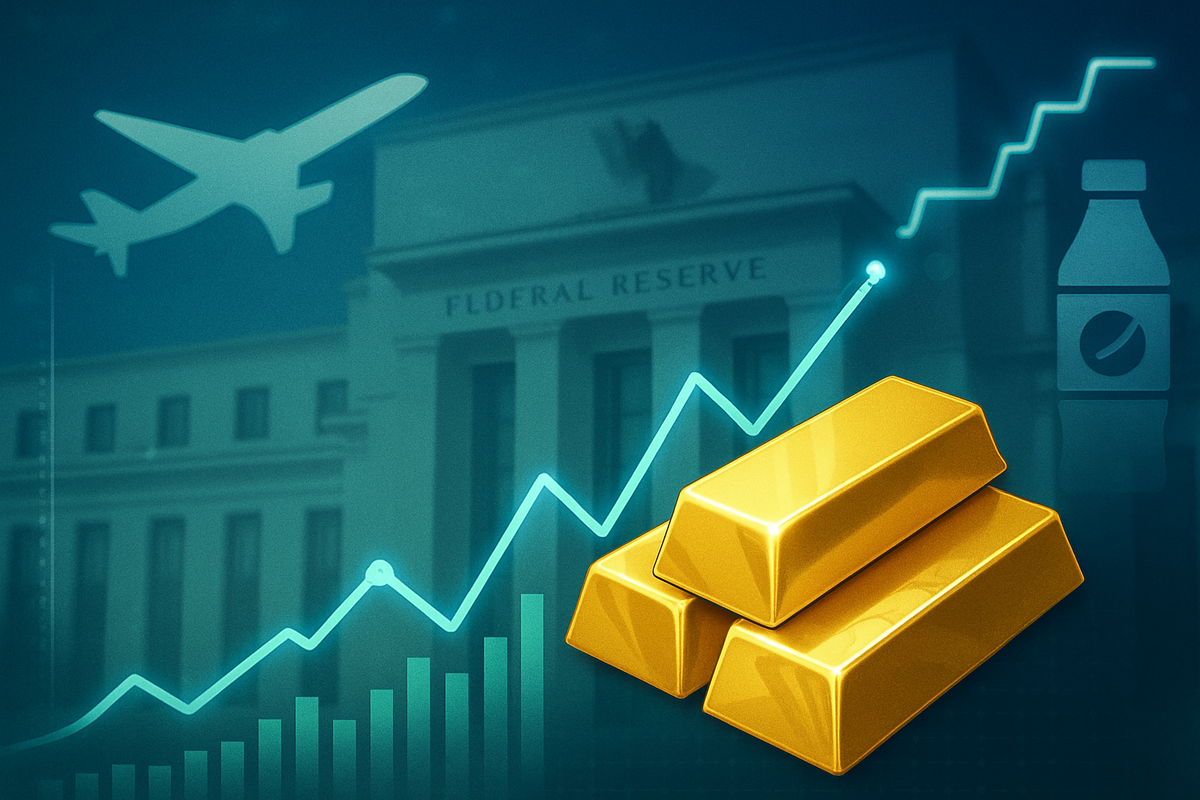Financial News
Market Minute: Fed Rate Cuts Reshape Landscape for US Stocks, Gold, and Corporate Giants Delta & PepsiCo

As October 2025 unfolds, financial markets are navigating a complex and often contradictory landscape. US equities continue to hover near all-time highs, buoyed by enthusiasm for artificial intelligence and a resilient, albeit cooling, economy. Simultaneously, gold has surged to unprecedented levels, crossing the $4,000 per ounce mark, as investors seek safe havens amidst persistent inflation and geopolitical uncertainties.
At the heart of these divergent trends is the Federal Reserve, which recently initiated a series of interest rate cuts, signaling a pivot towards a more accommodative monetary policy. This shift is reverberating across sectors, influencing everything from high-flying tech stocks to established consumer staples and travel giants. The latest earnings from bellwethers like Delta Air Lines (NYSE: DAL) and PepsiCo (NASDAQ: PEP) offer a microcosm of this evolving environment, presenting a mixed picture of corporate resilience and strategic challenges.
The Fed's Dovish Pivot and a Tale of Two Markets
The Federal Reserve has decisively shifted its monetary policy in 2025, initiating a rate-cutting cycle that has profound implications for financial markets. In September 2025, the FOMC delivered its first 25-basis-point reduction since December 2024, lowering the federal funds rate to a range of 4.00%-4.25%. This move was largely characterized as a "risk management cut," preempting a further slowdown in the labor market. Looking ahead, market participants and the Fed's own "dot plot" projections anticipate at least one more 25-basis-point cut by year-end, likely in late October or December, bringing the rate potentially to 3.75%-4.00%.
This dovish pivot by the Fed has been a significant catalyst for gold, which has enjoyed a historic rally throughout 2025. Surpassing the $4,000 per ounce mark for the first time in October, gold prices have surged approximately 50% since January. The precious metal's ascent is fueled by a confluence of factors: heightened global economic uncertainty, geopolitical tensions in regions like Gaza and Ukraine, and persistent inflation above the Fed's 2% target. Crucially, the Fed's rate cuts reduce the opportunity cost of holding non-yielding assets like gold, making it more attractive. Unprecedented central bank purchases, a weakening US dollar, and robust inflows into gold ETFs have further cemented its safe-haven status and upward trajectory.
Meanwhile, US stock markets present a seemingly contradictory picture, with both the S&P 500 (INDEXSP: .INX) and NASDAQ Composite (NASDAQ: COMP) reaching fresh all-time highs in October 2025. This resilience is largely attributed to the ongoing artificial intelligence (AI) boom, which continues to drive significant investment and optimism in technology stocks, with global AI spending projected to hit $375 billion in 2025. Anticipated lower interest rates also provide a favorable environment for equities, supporting higher valuations and stimulating corporate activity. Corporate earnings projections remain robust, with S&P 500 companies expected to achieve a 15% increase in earnings in 2025. However, this market strength is accompanied by a record level of concentration, with the "Magnificent 7" tech giants, including Apple (NASDAQ: AAPL), Microsoft (NASDAQ: MSFT), Nvidia (NASDAQ: NVDA), Amazon (NASDAQ: AMZN), Alphabet (NASDAQ: GOOGL), Meta (NASDAQ: META), and Tesla (NASDAQ: TSLA), accounting for a substantial portion of the S&P 500's value and driving much of its returns.
Despite the market's bullish run, underlying economic indicators present a mixed bag. While US GDP saw a strong rebound in Q2 2025, overall growth is expected to moderate to 1.6% in 2025. Inflation, though initially cooling, has reportedly crept higher in Q3 2025, projected to reach nearly 4% by year-end due to tariff pass-throughs. The labor market, a key focus for the Fed, continues to show signs of softening, with downward revisions to job growth and a modest rise in unemployment. A downtrend in the US dollar has also been observed, benefiting multinational corporations but adding another layer of complexity to the economic outlook, especially with a recent US government shutdown further complicating data releases and policy assessments.
Corporate Barometers: Delta and PepsiCo Navigate Economic Crosscurrents
The broader economic shifts, particularly the Federal Reserve's rate cuts and persistent inflation, are creating distinct impacts on corporate giants like Delta Air Lines (NYSE: DAL) and PepsiCo (NASDAQ: PEP), as evidenced by their recent third-quarter 2025 earnings. While both companies are demonstrating resilience, their strategies and challenges reflect the nuanced effects of the current market environment.
Delta Air Lines delivered a robust performance in Q3 2025, surpassing analyst expectations for both adjusted earnings per share (EPS) of $1.71 and revenue of $15.2 billion. This strength was primarily fueled by the continued resilience of premium travel demand, which saw a 9% year-over-year increase in revenue, alongside a notable resurgence in corporate travel. While main cabin revenue experienced a 4% decline, Delta's strategic focus on high-margin segments and its robust loyalty programs, including the SkyMiles partnership with American Express (NYSE: AXP), have allowed it to effectively manage inflationary pressures impacting fuel and labor costs. The airline's ability to command higher fares in its premium offerings has been crucial. For a capital-intensive industry, the Fed's rate cuts are a welcome development, potentially lowering borrowing costs for fleet modernization and stimulating broader consumer and business travel demand, further bolstering Delta's optimistic outlook for Q4 and reaffirming its full-year 2025 EPS guidance at the high end of $6.00.
In contrast, PepsiCo (NASDAQ: PEP) presented a more mixed picture in its Q3 2025 results. While adjusted EPS of $2.29 and revenue of $23.94 billion both edged past analyst forecasts, driven by strong international growth, particularly in the EMEA segment, North American volumes for its Frito-Lay snacks and beverages declined by 3% to 4%. PepsiCo has aggressively employed pricing strategies to offset the significant inflationary pressures on raw materials, manufacturing, and logistics. However, this has led to increased price sensitivity among North American consumers, who are increasingly trading down or opting for private labels. The Fed's rate cuts could offer some relief by potentially boosting consumer purchasing power, but PepsiCo is also facing pressure from activist investor Elliott Management, which has acquired a substantial stake and is advocating for operational simplification and potential divestitures.
To address these challenges, PepsiCo is embarking on significant cost optimization initiatives, including plant closures and product line reductions in its US snacks category. The company is also strategically expanding its portfolio towards "permissible" and functional products to align with evolving health-conscious consumer preferences. Despite the headwinds, PepsiCo has maintained its 2025 guidance for low-single-digit organic revenue growth and stable core constant currency EPS, signaling confidence in its long-term strategy and a projected return to mid-single-digit growth from 2026 onwards. The recent appointment of Steve Schmitt as its new CFO, effective November 10, 2025, underscores a renewed focus on cost discipline and pricing dynamics in a demanding market.
Wider Significance: A Shifting Economic Paradigm
The confluence of the Federal Reserve's rate cuts, gold's record-breaking surge, and the US stock market's concentrated rally in October 2025 signals a profound shift in the economic paradigm, with far-reaching implications across industries and for policymakers.
The Fed's strategic easing, driven by a softening labor market and manageable, albeit persistent, inflation (around 2.7-3% CPI), is designed to lower borrowing costs and stimulate economic activity, proactively averting a more severe downturn. This move aligns with a broader global trend of central banks adjusting policies in response to decelerating growth. For businesses, lower interest rates translate to reduced financing costs, potentially spurring investment and expansion, particularly in capital-intensive sectors like airlines, which could benefit Delta Air Lines (NYSE: DAL). Consumers also stand to gain from cheaper credit, potentially boosting discretionary spending, which could indirectly support consumer staples like PepsiCo (NASDAQ: PEP), though its North American segments are already battling price sensitivity. However, savers will likely see diminished returns on their deposits, and some banks may face squeezed net interest margins. The ongoing US government shutdown adds a layer of complexity, delaying crucial economic data and potentially influencing the Fed's future decisions.
Gold's historic rally, surpassing $4,000 per ounce and marking its biggest surge since the 1970s, underscores a pervasive sense of global economic uncertainty and geopolitical instability. From the US government shutdown to political turmoil in major economies and ongoing international conflicts, investors are increasingly flocking to gold as a traditional safe-haven asset. The weaker US dollar, a direct consequence of the Fed's accommodative stance, further enhances gold's appeal by making it more affordable for international buyers. This trend not only benefits gold mining companies but also highlights a broader investment strategy of diversification and hedging against inflation and policy risks, with central banks notably increasing their gold reserves. Historically, gold has consistently performed well during periods of monetary easing and global unease, serving as a reliable store of value.
Conversely, the US stock market's robust performance, particularly the S&P 500's (INDEXSP: .INX) numerous record highs, is largely fueled by the relentless enthusiasm for Artificial Intelligence. This "AI boom" has driven unprecedented investment and growth, particularly in a handful of mega-cap technology companies, often referred to as the "Magnificent Seven." While strong corporate earnings projections across many sectors contribute to the overall bullish sentiment, this extreme market concentration raises significant concerns about market breadth and potential systemic risk. The outsized influence of these tech giants means that any significant correction could trigger widespread ripple effects across their vast ecosystems of suppliers, partners, and customers. Regulators may increasingly scrutinize this concentration for antitrust implications and potential market fragility, drawing parallels to past speculative bubbles like the dot-com era. Despite the genuine innovation AI offers, the market's heavy reliance on a few players, coupled with weak consumer sentiment and a "two-speed" economy, suggests underlying vulnerabilities that warrant careful monitoring.
What Comes Next: Navigating a Dynamic Future
The path forward for US stocks, gold, and key corporate players will largely be dictated by the Federal Reserve's continued monetary policy adjustments and the interplay of global economic forces. With another 25-basis-point rate cut highly anticipated in October 2025, bringing the federal funds rate to 3.75%-4.00%, and further easing expected through early 2026, the market is bracing for a sustained period of accommodative policy.
For US stocks, the short-term outlook remains cautiously optimistic. Lower borrowing costs are expected to continue fueling corporate investment and consumer spending, providing tailwinds for equity valuations. Growth stocks, particularly those in the technology sector benefiting from the AI boom, and small-cap companies are poised to be key beneficiaries in this environment. Long-term, historical precedents suggest that rate-cutting cycles are often followed by strong equity returns, with the S&P 500 (INDEXSP: .INX) potentially reaching 6,000 by year-end 2025 if a "soft landing" materializes. However, the market's significant concentration in a few mega-cap tech stocks presents a vulnerability, and a slowdown in consumption or a faltering AI narrative could introduce considerable headwinds.
Gold's trajectory, having already soared past $4,000 per ounce, is likely to remain bullish in both the short and long term. While the immediate impact of the October rate cut may be largely priced in, the ongoing reduction in the opportunity cost of holding non-yielding assets, coupled with a weakening US dollar and persistent global uncertainties, will continue to support its ascent. Structural demand from central banks, particularly those in emerging markets diversifying away from the dollar, provides a durable floor for gold prices. However, a swift resolution to geopolitical tensions or an unexpected resurgence in inflation could prompt the Fed to adopt a more hawkish stance, potentially tempering gold's rally.
For individual companies, Delta Air Lines (NYSE: DAL) is expected to continue its strategic focus on debt reduction, leveraging its strong free cash flow to strengthen its balance sheet. Its largely fixed-rate debt profile offers stability, while continued investment in premium and international travel segments, coupled with stringent capacity management and cost controls, will be crucial to sustain profitability amidst fluctuating fuel prices and evolving travel demand. Meanwhile, PepsiCo (NASDAQ: PEP) will likely double down on innovation and portfolio diversification, introducing healthier and functional products to cater to changing consumer preferences. Its international growth engines are vital, and the company will need to skillfully navigate pricing strategies in North America to reignite volume growth while pursuing aggressive productivity and automation initiatives to offset inflationary pressures and address activist investor demands.
Emerging markets stand to gain significantly from the Fed's easing cycle, as a weaker US dollar can lead to currency appreciation and reduce imported inflation, allowing their own central banks to cut rates. With EM economies growing at double the rate of developed markets and exhibiting strong corporate fundamentals, capital inflows are likely to accelerate, presenting compelling investment opportunities. Nevertheless, lingering global trade policy uncertainties and geopolitical volatility remain significant challenges that could disrupt these positive trends.
Ultimately, the broader market faces several potential scenarios. A base case of a soft landing, characterized by controlled easing and robust corporate earnings, could see continued growth for stocks and and gold. A more bullish scenario would involve stronger-than-expected economic growth or further AI breakthroughs, propelling equities even higher. Conversely, a bearish scenario could emerge if inflation proves stubborn, forcing the Fed to reverse course, or if a significant recession takes hold, leading to market turbulence and potentially a temporary pullback in gold before its safe-haven qualities fully reassert themselves.
Comprehensive Wrap-up: Navigating a New Market Reality
October 2025 encapsulates a market in profound transition, shaped by an evolving Federal Reserve policy, persistent inflationary pressures, and a stark divergence in asset class performance. The Fed's commitment to easing, exemplified by its September rate cut and the highly anticipated subsequent cut this month, marks a proactive effort to bolster a softening labor market. Yet, this dovish stance unfolds against a backdrop of reaccelerating inflation, driven by tariff pass-throughs, creating a delicate balance that Fed Chair Jerome Powell describes as a "curious kind of balance."
The key takeaway for investors is the simultaneous surge in both risk-on assets and traditional safe havens. US stocks, particularly the AI-driven technology sector, continue to ride a wave of optimism, pushing major indices to new record highs. This "risk-on" sentiment, however, stands in contrast to the underperformance of defensive sectors like consumer staples, as exemplified by PepsiCo's (NASDAQ: PEP) modest year-to-date gains. Concurrently, gold's historic rally past $4,000 per ounce underscores deep-seated anxieties about global economic stability, geopolitical risks, and currency debasement, further fueled by robust central bank demand. The airline industry, with Delta Air Lines (NYSE: DAL) leading the charge, is experiencing strong demand recovery but remains constrained by supply chain issues and rising operational costs.
Looking ahead, the market's trajectory will hinge on the Fed's ability to navigate this complex environment. While continued liquidity from rate cuts is expected to support equities, particularly growth stocks and emerging markets, persistent inflation could force a re-evaluation of the Fed's dovish path. The lasting impact of this period could be a more sustained era of elevated inflation, reshaping consumer purchasing power and corporate profitability. Gold's enduring strength signals a long-term re-evaluation of reserve assets and a growing trend towards de-dollarization among global central banks.
Investors in the coming months should meticulously watch the Federal Reserve's every move, paying close attention to the outcome of the October FOMC meeting and any forward guidance for 2026. Crucial inflation data, especially core CPI and PCE figures, will indicate whether tariff impacts are broadening. Corporate earnings reports will provide vital insights into how companies like Delta and PepsiCo are managing input costs, adapting to shifting consumer behaviors, and pursuing strategic pivots. Finally, geopolitical developments and their influence on trade policies and commodity prices will remain a significant wildcard, capable of introducing volatility across all asset classes. In this dynamic landscape, agility, thorough fundamental analysis, and a keen eye on macroeconomic signals will be paramount for astute investors.
This content is intended for informational purposes only and is not financial advice
More News
View More




Recent Quotes
View More
Quotes delayed at least 20 minutes.
By accessing this page, you agree to the Privacy Policy and Terms Of Service.



